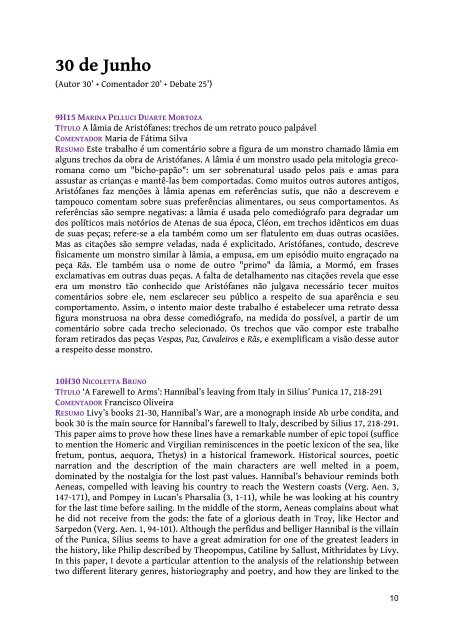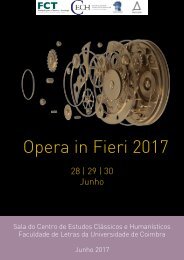Resumos PT
Create successful ePaper yourself
Turn your PDF publications into a flip-book with our unique Google optimized e-Paper software.
30 de Junho<br />
(Autor 30’ + Comentador 20’ + Debate 25’)<br />
9H15 MARINA PELLUCI DUARTE MORTOZA<br />
TÍTULO A lâmia de Aristófanes: trechos de um retrato pouco palpável<br />
COMENTADOR Maria de Fátima Silva<br />
RESUMO Este trabalho é um comentário sobre a figura de um monstro chamado lâmia em<br />
alguns trechos da obra de Aristófanes. A lâmia é um monstro usado pela mitologia grecoromana<br />
como um "bicho-papão": um ser sobrenatural usado pelos pais e amas para<br />
assustar as crianças e mantê-las bem comportadas. Como muitos outros autores antigos,<br />
Aristófanes faz menções à lâmia apenas em referências sutis, que não a descrevem e<br />
tampouco comentam sobre suas preferências alimentares, ou seus comportamentos. As<br />
referências são sempre negativas: a lâmia é usada pelo comediógrafo para degradar um<br />
dos políticos mais notórios de Atenas de sua época, Cléon, em trechos idênticos em duas<br />
de suas peças; refere-se a ela também como um ser flatulento em duas outras ocasiões.<br />
Mas as citações são sempre veladas, nada é explicitado. Aristófanes, contudo, descreve<br />
fisicamente um monstro similar à lâmia, a empusa, em um episódio muito engraçado na<br />
peça Rãs. Ele também usa o nome de outro "primo" da lâmia, a Mormó, em frases<br />
exclamativas em outras duas peças. A falta de detalhamento nas citações revela que esse<br />
era um monstro tão conhecido que Aristófanes não julgava necessário tecer muitos<br />
comentários sobre ele, nem esclarecer seu público a respeito de sua aparência e seu<br />
comportamento. Assim, o intento maior deste trabalho é estabelecer uma retrato dessa<br />
figura monstruosa na obra desse comediógrafo, na medida do possível, a partir de um<br />
comentário sobre cada trecho selecionado. Os trechos que vão compor este trabalho<br />
foram retirados das peças Vespas, Paz, Cavaleiros e Rãs, e exemplificam a visão desse autor<br />
a respeito desse monstro.<br />
10H30 NICOLETTA BRUNO<br />
TÍTULO ‘A Farewell to Arms’: Hannibal’s leaving from Italy in Silius’ Punica 17, 218-291<br />
COMENTADOR Francisco Oliveira<br />
RESUMO Livy’s books 21-30, Hannibal’s War, are a monograph inside Ab urbe condita, and<br />
book 30 is the main source for Hannibal’s farewell to Italy, described by Silius 17, 218-291.<br />
This paper aims to prove how these lines have a remarkable number of epic topoi (suffice<br />
to mention the Homeric and Virgilian reminiscences in the poetic lexicon of the sea, like<br />
fretum, pontus, aequora, Thetys) in a historical framework. Historical sources, poetic<br />
narration and the description of the main characters are well melted in a poem,<br />
dominated by the nostalgia for the lost past values. Hannibal’s behaviour reminds both<br />
Aeneas, compelled with leaving his country to reach the Western coasts (Verg. Aen. 3,<br />
147-171), and Pompey in Lucan’s Pharsalia (3, 1-11), while he was looking at his country<br />
for the last time before sailing. In the middle of the storm, Aeneas complains about what<br />
he did not receive from the gods: the fate of a glorious death in Troy, like Hector and<br />
Sarpedon (Verg. Aen. 1, 94-101). Although the perfidus and belliger Hannibal is the villain<br />
of the Punica, Silius seems to have a great admiration for one of the greatest leaders in<br />
the history, like Philip described by Theopompus, Catiline by Sallust, Mithridates by Livy.<br />
In this paper, I devote a particular attention to the analysis of the relationship between<br />
two different literary genres, historiography and poetry, and how they are linked to the<br />
10






